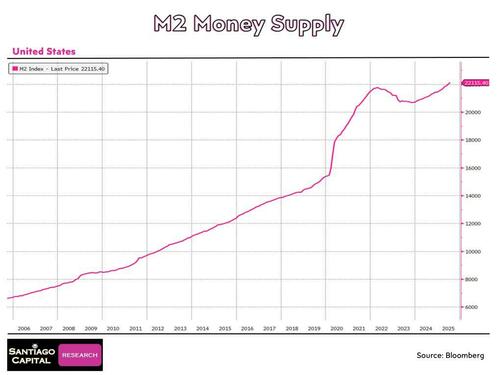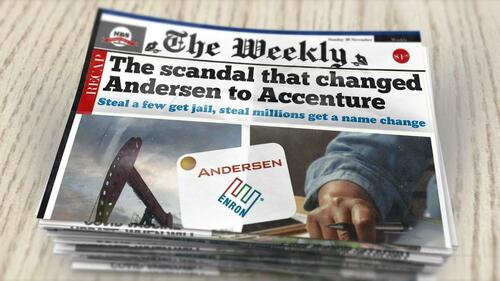Submitted by Brent Johnson, courtesy of MacroAlchemist.com
Investor Euphoria & The Anatomy of a Market Crash
Executive Summary
Markets operate in cycles of innovation and speculation, and the current surge in artificial intelligence is no exception.
The ongoing AI boom exhibits almost all the characteristics that have been seen in past bubbles—skyrocketing valuations, concentrated capital flows, euphoric investor sentiment, and media narratives that reinforce expectations of unstoppable growth. By many measures, the similarities go beyond resemblance: the speculative enthusiasm surrounding AI matches and in many ways surpasses the South Sea Bubble, the railway mania of the 1840s, the boom of the 1920s, the dot-com era, and the subprime mortgage frenzy.
At the heart of this surge lies a volatile mix of real technological potential, ample liquidity, and human psychology. Investors envision a world-altering transformation, credit is readily available to support risk-taking, and the fear of missing out drives behavior to extremes.
The outcome is an environment where both startups and established companies are valued as if flawless execution, continuous hypergrowth, and immediate widespread adoption were inevitable.
Such assumptions are not sustainable.
Every historical bubble has shown the danger of expectations straying too far from reality. In the late 1990s, the belief was that profits no longer mattered; today, many AI companies are projecting revenues and margins based on unproven scenarios.
As the gap between projections and actual results widens, the risks multiply. Financial losses are the most visible consequence, but history has shown that misconduct often follows. From the railway booms of the 19th century to Enron, WorldCom, and more recent mortgage excesses, periods of extreme optimism have created fertile ground for creative accounting, misrepresentation, and fraud.
The warning signs are well-documented.
Excessive valuations compared to tangible earnings, heavy concentration of capital in a few celebrated winners, and the easy availability of venture funding or leverage all raise systemic risk. The proliferation of complex financial products heightens fragility, turning minor disruptions into cascading stress events.
And as always, the declaration that “this time is different” resounds loudly in the background, encouraging herd behavior while discouraging rational analysis.
When both retail and institutional investors chase momentum trades rather than fundamentals, the system edges closer to its breaking point.
History also provides a roadmap for navigating these environments.
Investors who seek to engage in innovation without being consumed by its excesses must apply a disciplined, historically informed approach. This entails questioning the assumptions behind valuations, scrutinizing profit projections, monitoring leverage and liquidity conditions, and assessing whether business models are robust enough to withstand shocks.
It also involves cultivating behavioral awareness—recognizing that fear of missing out, herd mentality, and narrative fascination can overpower even the most experienced decision-makers.
Perhaps most crucially, vigilance against aggressive accounting or unrealistic guidance is essential, as the incentives for embellishment are strongest at speculative peaks.
This examination is not written from a standpoint of perpetual pessimism. It is a general exploration of the anatomy of market crashes, intended to offer a framework for understanding why speculative cycles form and how they unravel.
However, it is also timely. The current conditions suggest that a sharp correction is not a remote possibility but a near-term risk.
And the objective is not to instill fear.
Instead, it is to equip readers for the unexpected disruptions that history tells us arise just when everything seems calm. We believe that extraordinary opportunities will emerge once excesses are purged from the system, but to seize them, investors must first weather the volatility that lies ahead.
The following sections expand on this foundation, starting with the AI boom itself. As the most striking contemporary example of innovation intersecting with speculation, it offers a real-time case study of how opportunity and risk intertwine, laying the groundwork for both painful collapse and enduring revitalization.
Background
Financial markets have always swung between fear & greed, moments of stability & episodes of mania.
Crashes are seldom the outcome of completely unforeseen shocks; more often, they are the inevitable result of extended periods of investor euphoria. These euphoric phases are characterized by an intoxicating blend of extreme optimism, soaring valuations, easy access to credit, and the belief that some new technological or economic paradigm justifies disregarding the lessons of history.
This document delves into the anatomy of such euphoric cycles. It examines the conditions that allow optimism to flourish unchecked, the signals that can be observed in real-time, the distortions that only become apparent after collapse, and the enduring lessons investors can carry forward.
Historical examples ranging from tulip mania to the dot-com boom to the SPAC frenzy of 2021, combined with data on valuations, leverage, IPOs, and liquidity, provide the framework through which we analyze how manias evolve, why they disintegrate, and how disciplined investors can prepare for the aftermath.
Conditions That Breed Euphoria
Euphoria tends to be fueled by three main elements:
- Inflated valuations.
- Abundant credit.
- And a compelling narrative of progress.
Valuation serves as the most immediate indicator. Robert Shiller’s CAPE ratio offers a century-long perspective on how earnings multiples expand during speculative periods.
In 1929, CAPE climbed above 32 before plummeting to 5 in the depths of the Depression. In 2000, at the peak of the dot-com bubble, it reached 44—a record that remained until the present era, when CAPE once again rose into the high-30s.
Each peak was followed by years, even decades, of subdued returns.
Elevated valuations may not trigger an immediate collapse, but they consistently compress long-term forward returns, leaving markets susceptible to sudden shifts in sentiment.
Credit availability represents the second driving force.
Liquidity provided by banks, shadow lenders, or central banks amplifies speculation. Margin debt offers a stark example: it reached $278 billion in March 2000, $381 billion in July 2007, and $935 billion in October 2021, before surpassing $1 trillion in the current cycle. Each surge coincided with a wave of risk-taking; each retreat magnified losses as forced selling rippled through the system.

The third element is narrative.
Bubbles rarely emerge out of nothing; they are rooted in genuine shifts. Railroads in the nineteenth century, electrification and automobiles in the early twentieth, the internet in the 1990s, and AI and cryptocurrencies in the 2020s all presented credible visions of boundless growth. However, markets consistently priced these innovations with unrealistic speed and scale.

The phrase “this time is different” reverberates throughout every euphoric episode, used to justify valuations and leverage levels that would be deemed reckless in calmer times.
Signals Visible in Real Time
Even at the peak of mania, warning signs are discernible to those willing to look.
Retail investor surges are a common indicator. The 1920s witnessed households speculating in bucket shops with leveraged stock bets. The 1990s saw day traders armed with online brokerages and chat-room tips. In the 2020s, commission-free apps fueled meme-stock frenzies as millions piled into GameStop, AMC, and other speculative trades.
When investing transforms into cultural entertainment, markets are already deep in the euphoric phase.
Issuance is another signal.
Nearly 500 IPOs inundated markets in 1999, many from unprofitable companies. In 2021, over 1,000 listings, dominated by SPACs, eclipsed even that surge. These waves demonstrate not only investor appetite but also opportunism by issuers capitalizing on inflated valuations.
Price patterns often provide confirmation. Parabolic movements—where prices accelerate beyond sustainability—are the classic tell. The NASDAQ between 1998 and 2000, Bitcoin in 2017 and 2021, and certain AI stocks in 2023–2025 all exhibited this behavior. Media coverage follows suit, transitioning to relentless positivity, with tales of overnight millionaires and celebrity endorsements reinforcing the frenzy.
Speculative mania reaches its peak once it permeates the mainstream cultural consciousness.
Liquidity measures offer further evidence.
In 2020, U.S. M2 money supply expanded nearly 25% year-on-year—the fastest pace since World War II—fueled by stimulus checks, ultra-low rates, and massive asset purchases. This surge propelled booms in equities, crypto, and collectibles. When M2 contracted in 2022, risk assets plummeted sharply, revealing how dependent euphoria is on the tide of liquidity.

Signals Clearer Only in Hindsight
Other distortions only come to light after collapse.
Cheap capital enables malinvestment: dot-com companies burning through cash on marketing in the late 1990s, SPAC startups of 2020–2021 collapsing once easy funding evaporated. Hidden leverage is another revelation. In 2008, mortgage-backed securities and CDOs concealed systemic exposures; in 2022, crypto lenders failed for similar reasons.
Narratives also undergo a dramatic shift.
During booms, the focus is boundless growth. After crashes, scrutiny shifts to governance, unit economics, and sustainability. The shift from “how big can this get?” to “can this survive?” marks the reversal.
Accounting misrepresentation is another thread.
Enron remains the archetype: vendor financing, premature revenue recognition, and other tactics prolonged the illusion, until collapse became inevitable. When Enron collapsed, it took down Arthur Andersen, one of the world’s most prestigious accounting firms, highlighting how far-reaching the damage can be.

Behavioral Dynamics
Beneath these financial patterns lie recurring psychological forces.
Herding compels investors to follow the crowd, reinforcing momentum. Overconfidence convinces traders they will exit before the downturn, even as exposure builds. Narrative bias gives stories of transformation primacy over sober analysis. Risk perception erodes as practices once considered reckless become normalized.
This cycle of behavior repeats with uncanny consistency.
Case Studies in Euphoria
Speculative manias arise when optimism, innovation, and sudden wealth converge to ignite the collective imagination—and when easy credit offers the means for everyone to participate.
Each instance has its own cultural markers: tulips in 17th-century Holland, the South Sea schemes in Enlightenment England, radio and automobiles in 1920s America, internet startups at the turn of the millennium, securitized mortgages in the 2000s, and meme stocks during the pandemic era.
Beneath these surface differences lies a common emotional cycle: excitement, enthusiasm, greed, and, ultimately, panic.
Tulip Mania (1637)
The Tulip Mania of 1637 is often seen as the first major financial bubble.
It was never just about a flower. In the Dutch Golden Age, Amsterdam had become the hub of world trade, and merchants, craftsmen, and artisans were enriched by global commerce. Tulips, newly imported from the Ottoman Empire, were prized as luxury goods, with their vibrant colors and striking patterns caused by mosaic viruses.

To possess rare bulbs was to signify both taste and social status.
Soon, demand turned tulips from status symbols into speculative assets. What made the episode notable was how deeply it permeated Dutch society. Farmers, artisans, and small merchants speculated, often through futures contracts that allowed bets on bulbs that were never actually exchanged.
At its peak, a single bulb could fetch more than ten times the annual wage of a skilled worker, with stories of prices rivalling canal-side mansions.
When a regular auction failed to attract anticipated bids, confidence dissipated almost instantly. Prices crumbled, contracts became worthless, and while the Dutch economy absorbed the impact, the incident left a lasting lesson: when prestige and speculation merge, markets can detach from reality.
South Sea Bubble (1720)
The South Sea Bubble of 1720 followed a similar trajectory but with more significant institutional weight.
Early-eighteenth-century England was burdened with war debts, and the South Sea Company proposed an elegant solution: it would absorb the national debt in return for shares and monopoly rights to trade with Spanish South America. Promoted by politicians and endorsed as virtually risk-free, the scheme sent shares soaring.

Investors ranged from the aristocracy to regular citizens, with even the royal family participating. The Enlightenment era optimism fostered faith in limitless opportunities, and opportunists launched numerous copycat ventures—some comically vague, such as “a company for carrying out an undertaking of great advantage, but nobody to know what it is.”
When it became apparent that South Sea’s trading prospects were illusory and its debt-conversion model unsustainable, the bubble burst.
Families lost fortunes, public anger grew, and Parliament was compelled to investigate.
The lesson extended beyond speculation: it underscored the perilous interplay between state endorsement, finance, and public trust, a formative moment in British financial history.
1929 Crash
The Wall Street Crash of 1929 captured the euphoric blend of technological innovation, cultural exuberance, and financial leverage.
The 1920s were transformative: automobiles expanded mobility, radios connected households, and electric appliances revolutionized daily life. Jazz, cinema, and the cultural vibrancy of the decade reinforced the belief that a new era of prosperity was everlasting. Corporate profits surged, stock ownership broadened, and margin loans enabled investors to purchase shares with borrowed money.
Newspapers and radio personalities glorified the market as a one-way ticket to wealth.
By 1929, valuations were stretched to the limits, but the cultural faith in progress drowned out skepticism. When the downturn arrived, margin calls snowballed into panic selling. The crash marked the abrupt conclusion of the Roaring Twenties, shattering confidence in markets and ushering in the hardships of the Great Depression.

